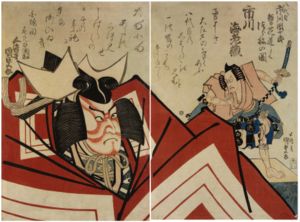Aragoto

Aragoto (荒事), or rough style,[1] is a style of kabuki acting that uses exaggerated, dynamic kata (forms or movements) and speech. Often, aragoto actors wear bold red or blue makeup (kumadori), and have costumes that are padded and enlarged. The term aragoto is an abbreviation of the term aramushagoto, which literally means "wild-warrior style".[2]
The style was created and pioneered by Ichikawa Danjūrō I,[3] an actor in the Edo period, and has come to be epitomized by his successors in the Ichikawa Danjūrō line. Roles such as the leads in Sukeroku and Shibaraku are particularly representative of the style. Aragoto is often contrasted with wagoto (soft or gentle) style, which emerged around the same time[1] but focuses on more naturalistic drama. It is also contrasted with onnagata or female-like style.[4]
References
- ^ a b McDonald, Keiko I. (1994). Japanese Classical Theater in Films. Rutherford: Fairleigh Dickinson University Press. p. 43. ISBN 0838635024.
- ^ Cavaye, Ronald (2012-07-09). Kabuki a Pocket Guide. Tuttle Publishing. ISBN 9781462903993.
- ^ Takashi, Ogata; Taisuke, Akimoto (2019). Post-Narratology Through Computational and Cognitive Approaches. Hershey, PA: IGI Global. p. 203. ISBN 9781522579809.
- ^ Mezur, K. (2005). Beautiful Boys/Outlaw Bodies: Devising Kabuki Female-Likeness. New York: Palgrave Macmillan. p. 30. ISBN 9781349529919.
- "Aragoto in Kabuki Glossary". Kabuki21.com. Archived from the original on 19 February 2007. Retrieved 2007-03-05.
